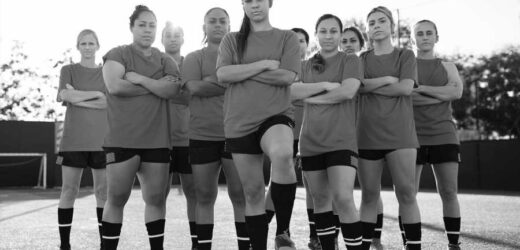Opinions expressed are solely those of the author and do not reflect the views of Rolling Stone editors or publishers.
This year marks the 50th anniversary of Title IX’s enactment. The landmark civil rights law prohibited sex-based discrimination by federally-funded education programs, paving the way for female student-athletes like me to receive fairer treatment.
As a retired Olympian and professional athlete who benefited from Title IX’s enactment, I am grateful for what June 23 represents. I have great respect for the journey and thank the trailblazers who got us here. This includes icons like Billie Jean King who advocated tirelessly for decades, forming nonprofits like Women’s Sports Foundation to support female involvement in sports. Those who played a vital role in developing women’s sports into a can’t-miss investment opportunity are getting their due, and it is thrilling to see them capture the spotlight this summer across media.
Related Stories
Beyoncé Joins TikTok and Shares First Video Thanking Fans for Releasing the 'Wiggle'
RS Recommends: AirPods Start at Just $99 as Part of Surprise Apple Sale
Related Stories

'Silence of the Lambs': 'It Broke All the Rules'
How Guns N' Roses Formed
If June 23 felt like one big women’s sports celebration, it’s because it was. There is so much to be appreciative of: The day transcends sports and has implications on culture and human rights at large. And as proud as I am of where things stand now, I have even more optimistic anticipation for what the world looks like following another 50 years of Title IX. Here is how I see the next 50 years of Title IX unfolding:
In 2072, Title IX will still likely be in place.
This is because, in 50 years, collegiate women’s sports will equal the status of men’s sports, full stop. The quality of on- and off-field products will be indistinguishable between the two. Women’s programs will be revenue-generators with some likely to outperform their male counterparts, which I believe could even lead to athletic directors cutting men’s programs along the way. This could coincide with college athletics transforming to operate like professional sports do, with organizations basing decisions on the behavior of their consumers (fans) and ROI.
Why do I think this? Data shows this progression is already underway.
We’re seeing some of the world’s biggest brands investing in women’s sports and they’re following through by shifting the budget to women athletes and leagues. The uptick in sponsorship activity seen this year is just the start; women’s sports will be thriving globally in 50 years because stakeholders will continue to choose them past the point of parity.
Research from my company, Sports Innovation Lab, has found that fans of women’s sports have a higher brand affinity to sponsors than fans of men’s sports do, making them a potentially higher-value target audience. As prototypical “fluid fans,” they watch games longer, are more technologically savvy and spend year-round on merchandise, events and social causes. This equates to higher revenue potential per fan.
The market for women’s sports is on a sharp rise and just getting started.
Sports are a reflection of society.
In 2072, we’ll look back on today with fond eyes seeing how far the sports industry has come in achieving equity, and marvel at how college sports reflect broader society.
Sports will be a human right as part of an active lifestyle, and the entertainment byproduct will be nearly indistinguishable across genders. Fans will be equally engaged regardless of participant gender, as sports will be accessible to anyone and consumed by everyone. From youth programs to the pros, governing bodies will no longer give preferential treatment to men because financial incentives to do so will no longer exist—and hopefully because we will have also culturally accepted in our hearts and minds that women belong in sports.
The Rolling Stone Culture Council is an invitation-only community for Influencers, Innovators and Creatives. Do I qualify?
Increased media coverage of collegiate and professional female athletes today will have a lot to do with that. If sports are a reflection of society, boys and girls are more likely to play if they see representation. I believe that within the next 50 years, boys and girls will only know a life in which positive images of women on and off the field exist as a standard on culturally prominent channels.
This equality of visibility can lead to girls “seeing and believing,” choosing to participate in sports knowing they can make a career from it. No longer ostracized at puberty, they could stay in the game longer and participate through the collegiate level. They’ll form deep relationships with their universities, become leaders in their fields thanks to the educational opportunities that Title IX provides, and reduce the gender wage gap as a result of diminishing gender-based inequities.
Society is shifting hand-in-hand with the evolution of the sports industry, and I believe everyone stands to gain from this positive development.
Title IX is the compass guiding the sports industry to equity.
The business of college sports is rapidly changing. Women athletes of all levels are already cashing in huge on NIL deals. I believe this is because brands know they could potentially offer greater ROI than their male counterparts. The writing is on the wall. From my perspective, the NCAA has its work cut out to adapt to the coming series of cultural, technological and financial shifts.
Brands are recognizing the potential value of investing in women’s sports, athletes are receiving a larger spotlight to inspire youth participants, and on-field product is improving, drawing greater revenue for teams and brands alike. Sold-out stadiums and record viewership figures for women’s events are newsworthy indicators today of potential, but soon they’ll be ubiquitous.
As women’s sports grow into prominence over the next 50 years, universities will likely be forced to think creatively about how they protect both men’s and women’s sports. Through it all, Title IX will continue to protect equal educational opportunities as men could more frequently rely on its protection.
Fans of women’s sports are a valuable, yet largely untapped consumer base.
It should not have to be a bold prediction that in 50 years, men and women will be treated equally. When we get there, we will look back on 2022 and ponder why it took us so long.
Source: Read Full Article


